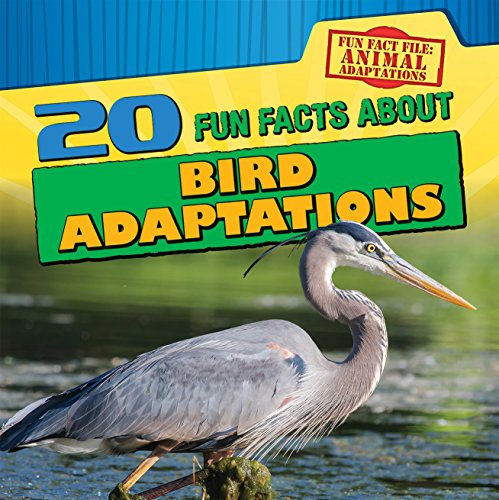-
20 Fun Facts About Insect Adaptations
Kristen Rajczak Nelson
Paperback (Gareth Stevens Pub, Aug. 15, 2016)Insects are often the same color as their surroundings. Their mouthparts developed for exactly the food they like to eat. Grasshoppers have long, strong back legs for hopping over grass, whereas the cockroachs long, thin legs let them run very quickly. None of this is an accident. Insects have many incredible adaptations that have made them the perfect residents of their environment. Short, easily digestible information draws readers into the insect world and introduces important science concepts. Full-color photographs allow readers to see adaptations and more up close. U
U
-
20 Fun Facts About Bird Adaptations
Sarah Machajewski
Paperback (Gareth Stevens Pub, Aug. 15, 2016)When Darwin visited the Galapagos Islands, he found many kinds of finches there, each with a beak perfectly suited to the kind of food the bird commonly ate. The finches had adapted to their surroundings. Wing size, migration patterns, and more are all part of the fascinating bird adaptations included in this book. Readers explore all kinds of birds, bird behavior, and more in an entertaining format and colorful layout. Graphic organizers and full-color photographs complement the main content as readers fly from one fun fact to the next. S
S
-
20 Fun Facts About Amphibian Adaptations
Emily Jankowski Mahoney
Paperback (Gareth Stevens Pub, Aug. 15, 2016)Reptiles lay their eggs on land and most spend a lot of their time out of the water. While this is a fact today, it wasnt always this way. Living on land is an adaptation reptiles underwent millions of years ago. Even more adaptations, such as how reptiles regulate their body temperature and their scaly skin, are more apparent to those studying crocodiles, turtles, and other reptiles in modern times. Using a unique format of short facts, this book introduces readers to the science concepts of evolution as well as the features that classify an animal as a reptile. R
R
-
20 Fun Facts About Marine Animal Adaptations
Tayler Cole
Paperback (Gareth Stevens Pub, Aug. 15, 2016)Marine animals have adapted to their habitat over millions of years. Huge whales and giant squids have been able to grow exceptionally large despite the absence of strong limbs due to the buoyancy of living in salt water. Blubber keeps some animals warm in the deep as other adaptations let animals live in very warm waters. Readers dive into the complex and fascinating subject of life under the sea through 20 interesting facts about how bodies, predation, camouflage, and more have evolved below the surface. U
U
-
20 Fun Facts About Mammal Adaptations
Kristen Rajczak
Paperback (Gareth Stevens Pub, Aug. 15, 2016)One major adaptation of mammals is part of what differentiates them from other animals: the growth and nourishment of babies inside the mothers body. Water-repelling fur, tough hides, camouflage, as well as the size and shape of various body parts are just a few other adaptations mammals have developed in order to better survive their environment. Readers learn many examples of how mammals have evolved to hide from predators and hunt for prey. Graphic organizers present even more information to aid readers understanding while full-color photographs bring them close to animals they might otherwise only see in a zoo. U
U
-
20 Fun Facts About Reptile Adaptations
Barbara M Linde
Paperback (Gareth Stevens Pub, Aug. 15, 2016)Reptiles lay their eggs on land and most spend a lot of their time out of the water. While this is a fact today, it wasnt always this way. Living on land is an adaptation reptiles underwent millions of years ago. Even more adaptations, such as how reptiles regulate their body temperature and their scaly skin, are more apparent to those studying crocodiles, turtles, and other reptiles in modern times. Using a unique format of short facts, this book introduces readers to the science concepts of evolution as well as the features that classify an animal as a reptile. S
S
-
20 Fun Facts About Bird Adaptations
Sarah Machajewski
Library Binding (Gareth Stevens Pub, Aug. 15, 2016)Offers facts about birds, demonstrating how they have adapted their appearance and behavior to survive a variety of conditions and climates. O
O
-
20 Fun Facts About Reptile Adaptations
Barbara M. Linde
Library Binding (Gareth Stevens Pub, Aug. 15, 2016)Offers facts about snakes, alligators, chameleons, lizards, and other reptiles, demonstrating how they have adapted their appearance and behavior to survive in their environments. O
O
-
20 Fun Facts About Mammal Adaptations
Kristen Rajczak
Library Binding (Gareth Stevens Pub, Aug. 15, 2016)Offers facts about mammals, demonstrating how they have adapted their appearance and behavior to survive a variety of conditions and climates. O
O
-
20 Fun Facts About Marine Animal Adaptations
Taylor Cole
Library Binding (Gareth Stevens Pub, Aug. 15, 2016)Provides information about puffer fish, anglerfish, sharks, octopuses, sea horses, and other marine animals to demonstrate how they have adapted their appearance and behavior to survive in the ocean. O
O
-
20 Fun Facts About Hippos
Therese M Shea
Paperback (Gareth Stevens Pub Learning library, Jan. 1, 2012)Provides information about hippopotamuses, including anatomy, young, and aggressiveness. U
U
